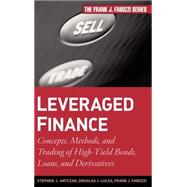
Note: Supplemental materials are not guaranteed with Rental or Used book purchases.
Purchase Benefits
What is included with this book?
Stephen J. Antczak, CFA, is an Executive Director at UBS. Prior to joining UBS in 2001, he was a senior strategist at Merrill Lynch, and he has also worked at the Bureau of Labor Statistics as an economist. Antczak graduated from the University of Michigan with a BA in economics and an MBA in business economics and finance.
Douglas J. Lucas has been a Group Managing Director and Director of Ratings Research at Moody's Investor Service since November 2008. Prior to that, he was head of CDO Research at UBS. Lucas has a BA magna cum laude in economics from UCLA and an MBA with Honors from the University of Chicago.
Frank J. Fabozzi, PhD, CFA, CPA, is Professor in the Practice of Finance and Becton Fellow at Yale University's School of Management, Editor of the Journal of Portfolio Management, and Associate Editor of the Journal of Structured Finance and the Journal of Fixed Income.
About the Authors.
Chapter 1: Introduction.
Part One: The Cash Market.
Part Two: The Structured Markets.
Part Three: The Synthetic Markets.
Part Four: How to Trade the Leveraged Finance Market.
Part Five: Default Correlation.
Part One: The Cash Market.
Chapter 2: The High-Yield Bond Market.
The Reasons Companies Are Classified as High-Yield Issuers.
Size and Growth of the Cash Market.
Types of Structures.
A Look at Ratings.
Risk and Return for Bonds.
What's Priced In?
How About Recoveries?
Summary.
Chapter 3: Leveraged Loans.
A Tale of Two Loans.
Introduction to Leveraged Loans.
An Overview of Loan Terms.
Loan Recovery Rates.
Loan Default Rates.
Summary.
Part Two: Structured Market.
Chapter 4: Collateralized Loan Obligations.
Understanding CLOs.
Elaborations and Details.
Summary.
Chapter 5: CLO Returns.
Default and Recovery Scenarios.
Distressed Loan Prices, Overflowing Triple-C Buckets, and CLO Returns.
Summary.
Chapter 6: CLO Portfolio Overlap.
Collateral Overlap in U.S. CLOs.
Collateral Vintage vs. Deal Vintage.
Favorite CLO Credits.
Single-Name Risk and Tranche Protections.
Excess Over-Collateralization and Excess Over-Collateralization Delta.
Senior and Subordinate Excess OC Deltas.
Equity Tranches and Distressed Tranches.
Summary.
Part Three: Synthetic Markets.
Chapter 7: Credit Default Swaps and the Indices.
What Are Credit Default Swaps?
Who Uses Protection, and for What?
Growth of the Market.
Marking-Market: SDV01.
Credit Default Swaps Indices.
Contrasting the LCDX and CDX Indices.
Beta: A Study of Movement..
Summary.
Chapter 8: Index Tranches.
Basic Mechanics of the Tranche Market.
Loan Tranches.
Summary.
Part Four: How to Trade the Leveraged Finance Market.
Chapter 9: Recessions and Returns.
Broad Market Performance.
Sector Performance.
Performance by Rating.
Summary.
Chapter 10: Framework for the Credit Analysis of Corporate Debt.
Approaches to Credit Analysis.
Industry Considerations.
Financial Analysis.
Quantitative Models.
Summary.
Chapter11: Trading the Basis.
The Basic Basis Package.
Constructing the Basic Package.
Moving Away from the Basic Model.
Adding Positive Convexity.
Negative Convexity.
A More Complex Basis Package.
Hedge Ratios for CLO Hedging.
Summary.
Chapter12: How Much Should You Get Paid to Take Risk?
Single Name Credit Risk.
Curve Risk.
Basis Risk.
Capital Structure Risk.
Summary.
Part Five: Default Correlation.
Chapter 13: Default Correlation: The Basics.
Default Correlation Defined.
Default Probability and Default Correlation.
Summary.
Chapter 14: Empirical Default Correlations: Problems and Solutions.
Empirical Results.
Problems with Historical Default Correlations.
Proposed Solutions.
Summary.
Index.
The New copy of this book will include any supplemental materials advertised. Please check the title of the book to determine if it should include any access cards, study guides, lab manuals, CDs, etc.
The Used, Rental and eBook copies of this book are not guaranteed to include any supplemental materials. Typically, only the book itself is included. This is true even if the title states it includes any access cards, study guides, lab manuals, CDs, etc.